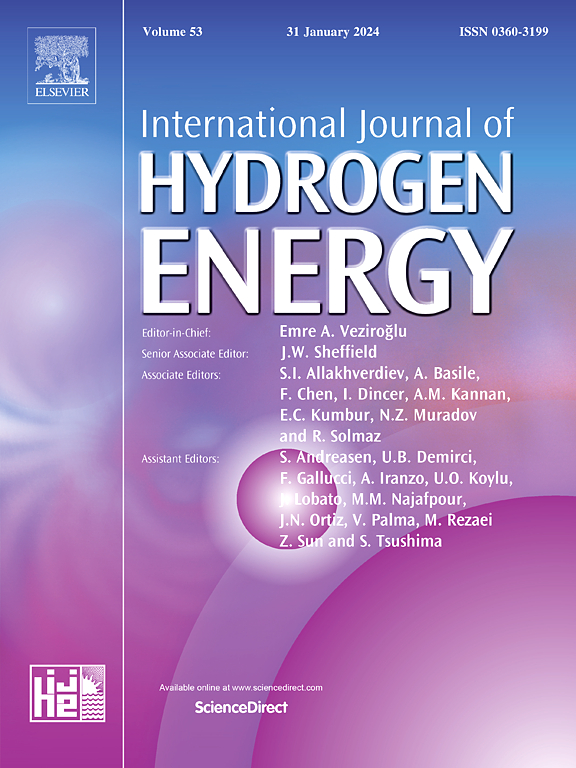推进制氢:预处理与硼催化剂的协同作用
IF 8.3
2区 工程技术
Q1 CHEMISTRY, PHYSICAL
引用次数: 0
摘要
本研究对能源作物芒草和城市污水处理污泥生产富氢合成气进行了评价。考察了生物质预处理、气化条件(温度、催化剂含量、催化剂与生物质比)和产氢率的影响。探讨了催化和非催化两种生物质蒸汽气化方法。催化生物质蒸汽气化采用了一种新开发的以硼负载碱基材料和生物质原料为原料的催化剂,旨在实现产品气中氢气成分高于非催化蒸汽气化。分析了生物质蒸汽气化合成气的组成,确定了H2和CO组分以及其他气体副产物。利用Box-Behnken设计进行优化研究,确定了影响氢气生成的参数以及催化对气化效率的影响。在以芒草为模型生物质的催化气化实验中,发现H2浓度为900°C,硼含量为10.0%,生物质-催化剂比为0.65的最佳条件。结果表明,产物气中氢含量为62.88%,表明该催化剂在脱焦油过程中具有重要作用。本文章由计算机程序翻译,如有差异,请以英文原文为准。
Advancing hydrogen production: The synergy of pretreatment and boron catalysts
This study evaluates the production of hydrogen-rich synthesis gas from the energy crop Miscanthus x giganteus and municipal wastewater treatment sludge. The effects of biomass pretreatment, gasification conditions (temperature, catalyst content, and catalyst-to-biomass ratio), and hydrogen yield were investigated. Both catalytic and non-catalytic biomass steam gasification methods were explored. Catalytic biomass steam gasification employed a newly developed catalyst using boron-supported alkali-based materials and biomass feedstock, aiming to achieve a higher hydrogen gas composition in the product gas compared to non-catalytic steam gasification. The composition of syngas produced by biomass steam gasification was analyzed to determine the H2 and CO components, as well as other gas byproducts. The optimization study, utilizing the Box-Behnken Design, identified parameters influencing H2 generation and the catalytic impact on gasification efficiency. In catalytic gasification experiments using hydrochar derived from miscanthus as the model biomass, optimal conditions for H2 concentration were found to be 900 °C, 10.0 % boron content, and a biomass-to-catalyst ratio of 0.65. The results demonstrated a hydrogen content of 62.88 % in the product gas, highlighting the significant role of the catalyst in tar removal.
求助全文
通过发布文献求助,成功后即可免费获取论文全文。
去求助
来源期刊

International Journal of Hydrogen Energy
工程技术-环境科学
CiteScore
13.50
自引率
25.00%
发文量
3502
审稿时长
60 days
期刊介绍:
The objective of the International Journal of Hydrogen Energy is to facilitate the exchange of new ideas, technological advancements, and research findings in the field of Hydrogen Energy among scientists and engineers worldwide. This journal showcases original research, both analytical and experimental, covering various aspects of Hydrogen Energy. These include production, storage, transmission, utilization, enabling technologies, environmental impact, economic considerations, and global perspectives on hydrogen and its carriers such as NH3, CH4, alcohols, etc.
The utilization aspect encompasses various methods such as thermochemical (combustion), photochemical, electrochemical (fuel cells), and nuclear conversion of hydrogen, hydrogen isotopes, and hydrogen carriers into thermal, mechanical, and electrical energies. The applications of these energies can be found in transportation (including aerospace), industrial, commercial, and residential sectors.
 求助内容:
求助内容: 应助结果提醒方式:
应助结果提醒方式:


